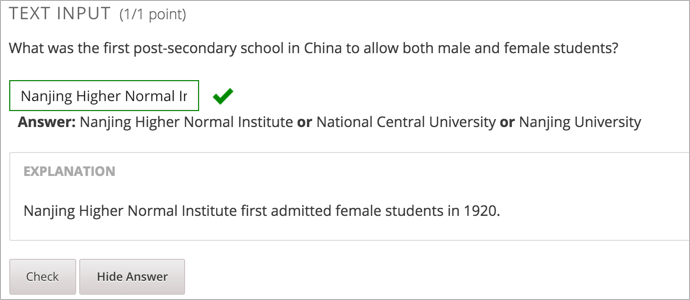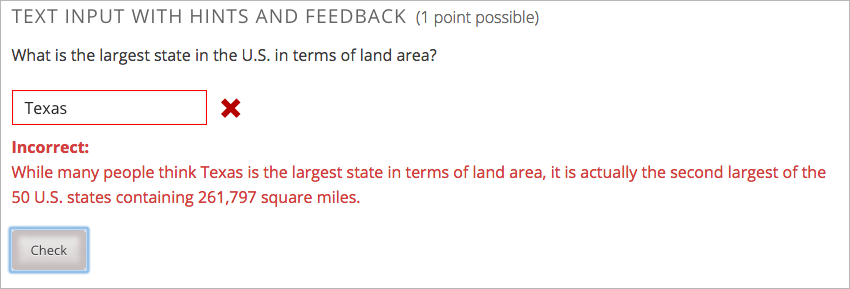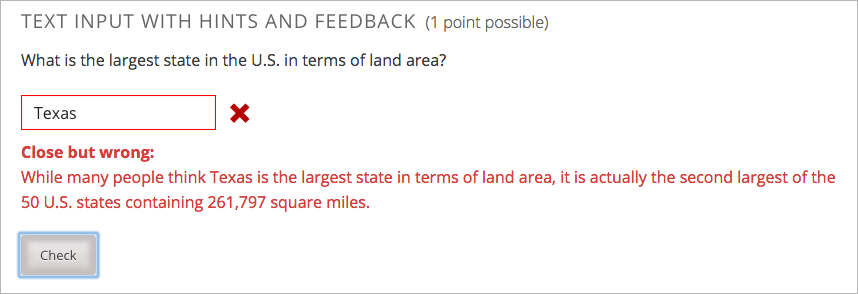8.44. Text Input Problem¶
Note
EdX offers full support for this problem type.
- Overview
- Analyzing Performance on Multiple Choice Problems
- Creating a Text Input Problem
- Use Feedback in a Text Input Problem
- Use Hints in a Text Input Problem
- Multiple Responses in Text Input Problems
- Add Text after the Text Response Field
- Case Sensitivity and Text Input Problems
- Response Field Length in Text Input Problems
- Regular Expressions in Text Input Problems
- Text Input Problem XML
- Deprecated Hinting Method
8.44.1. Overview¶
In text input problems, learners enter text into a response field. The response can include numbers, letters, and special characters such as punctuation marks. Because the text that the learner enters must match the instructor’s specified answer exactly, including spelling and punctuation, we recommend that you specify more than one correct answer for text input problems to allow for differences in capitalization and typographical errors.

8.44.2. Analyzing Performance on Multiple Choice Problems¶
For the text input problems in your course, you can use edX Insights to review aggregated learner performance data and examine submitted answers. For more information, see Using edX Insights.
8.44.3. Creating a Text Input Problem¶
You can create text input problems in the simple editor or in the advanced editor. You can set up a problem in the simple editor, and then switch to the advanced editor to add more configuration options in XML. However, you cannot switch back to the simple editor from the advanced editor. Therefore, you might want to format the problem as completely as possible before you begin to use the advanced editor.
8.44.3.1. Use the Simple Editor to Create a Text Input Problem¶
To use the simple editor to create a text input problem, follow these steps.
- In the unit where you want to create the problem, under Add New Component select Problem.
- Select one of the two text input problem templates.
From the list of Common Problem Types, select Text Input.
From the list of Common Problems with Hints and Feedback, select Text Input with Hints and Feedback. For more information, see Use Feedback in a Text Input Problem.
Studio adds the problem to the unit.
Select Edit. The simple editor opens.
Replace the sample problem text with your own text.
Determine the text that describes the question you want learners to answer, and surround that text with two pairs of angle brackets (
>>question<<). This text identifies the question for screen readers, reports, and Insights.Select the text of the problem’s answer, and then select Text Input from the toolbar. An equals signe (=) appears next to the answer.
You can identfy more than one correct answer. For more information, see Multiple Responses in Text Input Problems.
To provide an explanation, select the explanation text and then select Explanation from the toolbar.
[explanation]appears before and after the explanation text.Select Settings and provide an identifying Display Name for the problem.
Define additional settings for the problem. For more information, see Problem Settings.
Select Save.
For the example problem illustrated above, the following text displays in the problem component.
>>What was the first post-secondary school in China to allow both male and
female students?<<
= Nanjing Higher Normal Institute
or= National Central University
or= Nanjing University
[explanation]
Nanjing Higher Normal Institute first admitted female students in 1920.
[explanation]
8.44.3.2. Use the Advanced Editor to Edit a Text Input Problem¶
To use the advanced editor to edit a text input problem, follow these steps.
- Follow the steps for creating the problem in the simple editor.
- Select Advanced Editor, and then edit the XML to add the tags and attributes you want. An example follows.
Problem Code:
<problem>
<p>What was the first post-secondary school in China to allow both male and female students?</p>
<stringresponse answer="Nanjing Higher Normal Institute" type="ci" >
<additional_answer>National Central University</additional_answer>
<additional_answer>Nanjing University</additional_answer>
<textline label="What was the first post-secondary school in China to
allow both male and female students?" size="20"/>
</stringresponse>
<solution>
<div class="detailed-solution">
<p>Explanation</p>
<p>Nanjing Higher Normal Institute first admitted female students in
1920.</p>
</div>
</solution>
</problem>
8.44.4. Use Feedback in a Text Input Problem¶
You can add feedback in a text input problem using the simple editor or the advanced editor. For an overview of feedback in problems, see Adding Feedback and Hints to a Problem.
In text input problems, you can provide feedback for each option that a learner can select.
Use feedback on correct answers to reinforce why the answer is correct.
Use feedback on incorrect answers as an opportunity to address common learner misconceptions. Feedback for text input questions should also provide guidance to the learner on how to arrive at the correct answer.
8.44.4.1. Configure Feedback in the Simple Editor¶
In the simple editor, you configure answer feedback with the following syntax. When you create a new text input problem, select the template Text Input with Hints and Feedback. This template has example feedback syntax that you can replace.
= Correct Answer {{Feedback for learners who select this answer.}}
not= Incorrect Answer {{Feedback for learners who select this answer.}}
For example, the following problem has feedback for the correct answer and two common incorrect answers.
>>What is the largest state in the U.S. in terms of land area?<<
=Alaska {{Alaska is the largest state in the U.S. in terms of not only land
area, but also total area and water area. Alaska is 576,400 square miles,
more than double the land area of the second largest state, Texas.}}
not=Texas {{While many people think Texas is the largest state in terms of
land area, it is actually the second largest and contains 261,797 square
miles.}}
not=California {{California is the third largest state and contains 155,959
square miles.}}
8.44.4.2. Configure Feedback in the Advanced Editor¶
In the advanced editor, you configure answer feedback with the following syntax.
<stringresponse answer="Correct Answer" type="ci" >
<correcthint>Hint for correct answer.</correcthint>
<stringequalhint answer="Incorrect Anser">
Hint for incorrect answer.
</stringequalhint>
</stringresponse>
For example, the following problem has feedback for the correct answer and two common incorrect answers.
<problem>
<p>What was the first post-secondary school in China to allow both male and female students?</p>
<stringresponse answer="Alaska" type="ci" >
<correcthint>
Alaska is the largest state in the U.S. in terms of not only land
area, but also total area and water area. Alaska is 576,400 square
miles, more than double the land area of the second largest state,
Texas.
</correcthint>
<stringequalhint answer="Texas">
While many people think Texas is the largest state in terms of land
area, it is actually the second largest of the 50 U.S. states
containing 261,797 square miles.
</stringequalhint>
<stringequalhint answer="California">
California is the third largest state in the U.S. in terms of land
area containing 155,959 square miles.</stringequalhint>
<textline label="What is the largest state in the U.S. in terms of land
area?" size="20"/>
</stringresponse>
</problem>
8.44.4.3. Customize Feedback Labels¶
By default, the feedback labels shown to learners are Correct and Incorrect. If you do not define feedback labels, learners see these terms when they submit an answer, as in the following example.

You can configure the problem to override the default labels. For example, you can configure a custom label for a specific wrong answer.

Note
The default labels Correct and Incorrect are displayed in the learner’s requested language. If you provide custom labels, they are displayed to all users as you configure them and are not translated into different languages.
8.44.4.3.1. Customize Feedback Labels in the Simple Editor¶
In the simple editor, you configure custom feedback labels with the following syntax.
not=Answer {{Label:: Feedback}}
For example, the following feedback is configured to use a custom label.
not=Texas {{Close but wrong:: While many people think Texas is the largest
state in terms of land area, it is actually the second largest of the 50 U.S.
states, containing 261,797 square miles.}}
8.44.4.3.2. Customize Feedback Labels in the Advanced Editor¶
In the advanced editor, you configure custom feedback labels with the following syntax.
<stringequalhint answer="Incorrect Anser" label="Custom Label">
Feedback
</stringequalhint>
For example, the following feedback is configured to use a custom label.
<stringequalhint answer="Texas" label="Close but wrong">
While many people think Texas is the largest state in terms of land
area, it is actually the second largest of the 50 U.S. states containing
261,797 square miles.
</stringequalhint>
8.44.5. Use Hints in a Text Input Problem¶
You can add hints in a text input problem, using the simple editor or the advanced editor. For an overview of hints in problems, see Adding Feedback and Hints to a Problem.
8.44.5.1. Configure Hints in the Simple Editor¶
In the simple editor, you configure hints with the following syntax.
||Hint 1||
||Hint 2||
||Hint n||
Note
You can configure any number of hints. The learner views one hint at a time and views the next one by selecting Hint again.
For example, the following problem has two hints.
||A fruit is the fertilized ovary from a flower.||
||A fruit contains seeds of the plant.||
8.44.5.2. Configure Hints in the Advanced Editor¶
In the advanced editor, you configure each hint in the <hint> element
within the <demandhint> element.
<demandhint>
<hint>Hint 1</hint>
<hint>Hint 2</hint>
<hint>Hint 3</hint>
</demandhint>
For example, the following XML shows two hints.
<demandhint>
<hint>A fruit is the fertilized ovary from a flower.</hint>
<hint>A fruit contains seeds of the plant.</hint>
</demandhint>
8.44.6. Multiple Responses in Text Input Problems¶
You can specify more than one correct response for text input problems. For example, instead of requiring learners to enter “Dr. Martin Luther King, Junior” exactly, you can also allow answers of “Martin Luther King,” “Doctor Martin Luther King,” and other variations. To do this, you can use the simple editor or the advanced editor.
8.44.6.1. Simple Editor¶
To specify additional correct responses in the simple editor, include``or= `` before each additional correct response.
>>What African-American led the United States civil rights movement during
the 1960s?<<
= Dr. Martin Luther King, Jr.
or= Dr. Martin Luther King, Junior
or= Martin Luther King, Jr.
or= Martin Luther King
8.44.6.2. Advanced Editor¶
To specify additional correct responses in the advanced editor, add an
<additional_answer> for each correct response inside the opening and
closing <stringresponse> tags.
<problem>
<p>What African-American led the United States civil rights movement during the 1960s?</p>
<stringresponse answer="Dr. Martin Luther King, Jr." type="ci" >
<additional_answer>Dr. Martin Luther King, Junior</additional_answer>
<additional_answer>Martin Luther King, Jr.</additional_answer>
<additional_answer>Martin Luther King</additional_answer>
<textline label="What African-American led the United States civil rights
movement during the 1960s?" size="20"/>
</stringresponse>
</problem>
8.44.7. Add Text after the Text Response Field¶
You might want to include a word, phrase, or sentence after the answer field in a text input problem to help guide your students or resolve ambiguity.

To do this, you must use the advanced editor.
In the problem, locate the textline element. This element creates the
response field for the problem and is a child of the stringresponse
element. An example follows.
<stringresponse answer="Ashmun" type="ci" >
<textline label="What Pennsylvania school was founded in 1854 to provide
educational opportunities for African-Americans?" size="20" />
</stringresponse>
To add text after the answer field, add the trailing_text attribute
together with the text that you want to use inside the textline element.
<stringresponse answer="Ashmun" type="ci" >
<textline label="What Pennsylvania school was founded in 1854 to provide educational
opportunities for African-Americans?" size="20" trailing_text="Institute" />
</stringresponse>
8.44.8. Case Sensitivity and Text Input Problems¶
By default, text input problems do not require a case sensitive response. You can change this and require a case sensitive answer.
To make a text input response case sensitive, you must use The Advanced Editor.
In the advanced editor, you see that the type attribute of the
stringresponse element equals ci, for “case insensitive”. An example
follows.
<stringresponse answer="Michigan" type="ci">
<textline size="20"/>
</stringresponse>
To make the response case sensitive, change the value of the type
attribute to cs.
<stringresponse answer="Michigan" type="cs">
<textline size="20"/>
</stringresponse>
8.44.9. Response Field Length in Text Input Problems¶
By default, the response field for text input problems is 20 characters long.
You should preview the unit to ensure that the length of the response input field accommodates the correct answer, and provides extra space for possible incorrect answers.
If the default response field length is not sufficient, you can change it using the advanced editor.
In the advanced editor, in the XML block for the answer, you see that the
size attribute of the textline element equals 20.
<stringresponse answer="Democratic Republic of the Congo" type="ci">
<textline size="20"/>
</stringresponse>
To change the response field length, change the value of the size
attribute.
<stringresponse answer="Democratic Republic of the Congo" type="ci">
<textline size="40"/>
</stringresponse>
8.44.10. Regular Expressions in Text Input Problems¶
You can configure a text input problem to allow a regular expression as an answer. To do this, you modify the problem’s XML in the Advanced Editor.
The regular expression that the learner enters must contain the part of the
answer that the course team specifies. For example, if you
specify <answer="example answer" type="regexp">, correct answers
include example answered, two example answers, or even ==example
answer==, but not examples or example anser.
You can add regexp to the value of the type attribute, for example:
type="ci regexp" or type="regexp" or type="regexp cs". In this
case, any answers or hints are treated as regular expressions.
8.44.11. Text Input Problem XML¶
8.44.11.1. Template¶
<problem>
<p>Problem text</p>
<stringresponse answer="Correct answer 1" type="ci regexp">
<additional_answer>Correct answer 2</additional_answer>
<additional_answer>Correct answer 3</additional_answer>
<textline size="20" label="label text"/>
<correcthint>Provides feedback when learners submit the correct response.</correcthint>
<stringequalhint answer="Incorrect answer 1">Provides feedback when learners submit the specified incorrect response.</stringequalhint>
<stringequalhint answer="Incorrect answer 2">Provides feedback when learners submit the specified incorrect response.</stringequalhint>
<textline label="Which U.S. state has the largest land area?" size="20"/>
</stringresponse>
<demandhint>
<hint>The first text string to display when learners request a hint.</hint>
<hint>The second text string to display when learners request a hint.</hint>
</demandhint>
</problem>
8.44.11.2. Tags¶
<stringresponse>: Indicates that the problem is a text input problem. The<stringresponse>tag has the following child tags.<textline>: Creates the response field in the LMS where the learner enters a response.<additional_answer>(optional): Specifies an additional correct answer for the problem. A problem can contain an unlimited number of additional answers.<correcthint>(optional): Specifies feedback for the correct answer.<stringequalhint>(optional): Specifies feedback for an incorrect answer.
<demandhint>(optional): Specifies one or more hints that learners can request to help them arrive at the correct answer. The<demandhint>tag has a child tag of<hint>.
Tag: <stringresponse>
Indicates that the problem is a text input problem.
Attributes
Attribute Description answer (required) Specifies the correct answer. To designate the answer as a regular expression, add “regexp” to the type attribute. If you do not add “regexp” to the type attribute, the learner’s answer must match the value in this attribute exactly. type (optional) Specifies whether the problem requires a case sensitive response and if it allows regular expressions.
- If the
<stringresponse>tag includestype="ci", the problem is not case sensitive.- If the tag includes
type="cs", the problem is case sensitive.- If the tag includes
type="regexp", the problem allows regular expressions.A type attribute in a
<stringresponse>tag can also combine these values. For example,<stringresponse type="regexp cs">specifies that the prolem allows regular expressions and is case sensitive.Children
<textline />(required)<additional_answer>(optional)<correcthint>(optional)<stringequalhint>(optional)
Tag: <textline />
Creates a response field in the LMS where the learner enters a response.
Attributes
Attribute Description label (required) Contains the text of the problem. size (optional) Specifies the size, in characters, of the response field in the LMS. hidden (optional) If set to “true”, learners cannot see the response field. correct_answer (optional) Lists the correct answer to the problem. trailing_text Adds the text that you specify after the response field. Children
(none)
Tag: <additional_answer>
Specifies an additional correct answer for the problem. A problem can contain an unlimited number of additional answers.
Attributes
(none)
Children
(none)
Tag: <correcthint>
Indicates that the course team has provided hints for certain common incorrect answers.
Attributes
(none)
Children
(none)
Tag: <stringequalhint>
Specifies the feedback for an incorrect answer.
Attributes
Attribute Description answer (required) The text of the incorrect answer. Children
(none)
Tag: <demandhint>
Specifies one or more hints that learners can request to help them arrive at the correct answer.
Attributes
(none)
Children
Tag: <hint>
Contains the text of a hint. The LMS shows each of the defined hints to the
learners in the order that the <hint> tags are included within the
<demandhint> tag.
8.44.12. Deprecated Hinting Method¶
The following example shows the XML format with the <hintgroup> element
that you could use in the past to configure hints for text input problems.
Problems using this XML format will continue to work in the edX Platform.
However, edX recommends that you use the new way of configuring hints
documented above.
<problem>
<p>Problem text</p>
<stringresponse answer="Correct answer 1" type="ci regexp">
<additional_answer>Correct answer 2</additional_answer>
<additional_answer>Correct answer 3</additional_answer>
<textline size="20" label="label text"/>
<hintgroup>
<stringhint answer="Incorrect answer A" type="ci" name="hintA" />
<hintpart on="hintA">
<startouttext />Text of hint for incorrect answer A<endouttext />
</hintpart >
<stringhint answer="Incorrect answer B" type="ci" name="hintB" />
<hintpart on="hintB">
<startouttext />Text of hint for incorrect answer B<endouttext />
</hintpart >
<stringhint answer="Incorrect answer C" type="ci" name="hintC" />
<hintpart on="hintC">
<startouttext />Text of hint for incorrect answer C<endouttext />
</hintpart >
</hintgroup>
</stringresponse>
<solution>
<div class="detailed-solution">
<p>Explanation or Solution Header</p>
<p>Explanation or solution text</p>
</div>
</solution>
</problem>